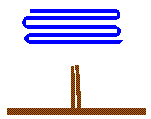Ribbons,
Roses
and
Wraps
The ribbon portion of Lesson 1 will deal with making bows. Bows are found all through the crafting world and in our daily lives. Packages are made fancier, wreaths are embellished and home decor is enhanced by the use of bows. The type of materials used to make your bows is endless but here we will confine our efforts to ribbon. Many of these techniques can be transferred to other materials.
We will be making the following bows in the lesson:
These bows are not difficult to make but are quite awkward feeling until you get used to holding and working with the ribbon. As with all learning, practice makes perfect. I strongly recommend you recycle ribbon for your practice. Ironing the ribbon will usually restore the crispness and make the recycled ribbons feel and handle much like new ribbon.
The two major types of ribbon are woven edged and craft ribbon. Both these ribbon types can be single faced (having a definite right & wrong side) or double faced (no difference in the front and back).
Woven edged ribbon has a woven in picot (small loops of thread on one or both edges) or selvage finishing the edges. These are usually softer than craft ribbon as they do not contain sizing. These are the ribbons that should be used on clothing or where they will be washed. Among the woven edged ribbon you will find satin, velvet and grosgrain. This ribbon ravels so it cannot be cut lengthwise and sometimes a fray inhibitor must be used.
A small amount of white craft glue applied to the cut edge with your finger will seal the cut edge if you do not have a fabric fray checker.
******
Craft ribbon is fabric that has been treated with sizing and a fray preventative and is then cut in continuous strips. Because of these additives the ribbon has a crip feel and usually will not ravel when cut lengthwise. You can fold, twist and press it flat but it is not washable as a rule. Generally craft ribbon is made from cotton,velour or acetate and may have lace or trim sewn to the edge.
Some items, related to ribbons but not used in this class, are the ribbon shredder and the ribbon slitter. The shredder is an arrangement of pin like projections that when used with craft ribbon reduces the ribbon to fine strings of ribbon where the slitter has small knife blades that cut the ribbon in very thin strips (about 1/16" or less). Both these tools can be useful but take some practice to use correctly.

The Easy Bowz and the Easy Rose are tools on the market to hold the ribbon for you. They do not make the bow or rose but they do make it easier to hold the ribbon as you work. We will not use them in this workshop because I personally think you need to learn with only your two hands, the ribbon and the wire. After you have learned how that way, you can get these tools if you are planning to make bows to sell and need to make a large number in a short time.
A numerical code has been developed by ribbon manufacturers to identify common widths of ribbon. Many ribbons only come with this code so we have listed some of the most popular sizes here with their code number.
# 1 is 1/4" wide
#1 1/2 is 5/16" to 3/8" wide
# 2 is 7/16" to 1/2" wide
# 3 is 9/16" to 5/8" wide
# 5 is 7/8" wide
# 9 is 1 3/8" to 1 1/2" wide***
# 16 is 1 15/16" to 2 1/4" wide***
# 40 is 2 1/2" to 3" wide***
*** These three sizes are those most often used for package or presentation bows.
With the above introduction you are now ready to begin making bows! Click HERE for the detailed instructions.
In this portion of the lesson we have given you some specific instructions but the main point is to get you thinking of different ways to package a gift. That teen you are always asking to pick up his room wants a new jacket, packed in a wastebasket with a fancy bow may remind without words. A magazine subscription presented in a magazine rack or between book ends, a new toy in a back pack or toy box the ideas are endless and don't need to be expensive.
We will be doing the following projects:
With the above introduction you are now ready to begin the wrapping! Click HERE for the detailed instructions.
I like to start all my instructions with this sentence:
" The only stupid question is the one you didn't ask because it never gets answered."
Next lesson will be Roses.
© 1997, Internet Visions Co. All rights reserved. All trademarks are owned by Internet Visions Company.